Figs are among the earliest domesticated crops in human history, dating back 9,000 years in regions like modern-day Jordan and the Levant.
The Egyptians dried figs for year-round consumption, while the Greeks and Romans associated the fruit with fertility and prosperity.
The plants (Ficus carica) are native to the Middle East and Western Asia. In the mid-1700s, Spanish missionaries introduced them to California, along with the olive tree.
Fig trees can live for 50 to 75 years, sometimes even longer. Some trees can reach 50 feet, depending on the variety, conditions, and care. A healthy fig tree can be a multi-generational gift, providing delicious fruit for decades.

In California, some fig trees can grow up to 50 feet.
Best Fig Tree Varieties for Southern California
California is a leading producer of figs in the USA (Turkey is the global numero uno). Some of the best varieties for SoCal include:
- Black Mission is a classic favorite with sweet, dark purple fruit.
- Kadota has honey-colored fruit and a smooth texture.
- Brown Turkey is perfect for beginners. It produces fruit twice a year.
- Celeste is a smaller variety with exceptionally sweet fruit.
- Panache (Tiger Fig) bears striking green-and-yellow striped fruit with a rich, jammy flavor.
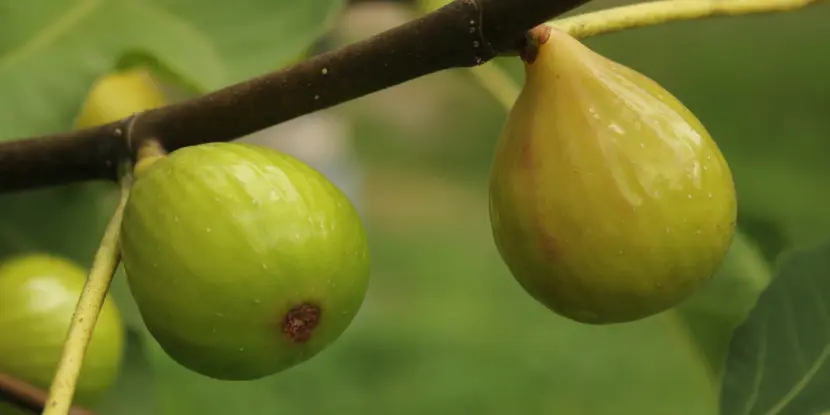
Kadota figs are honey-colored with a smooth texture.
Optimal Growing Conditions
Light
- Fig trees need at least 6–8 hours of sunlight daily.
- The sunnier the spot, the better your harvest will be.
Temperature
- Ideal temperatures are between 65°F and 80°F.
- Mature fig trees can handle some frost; young trees are more vulnerable and should be protected in colder climates.
- Trees can easily withstand temperatures exceeding 90°F, with sufficient water.
Soil
- Fig trees prefer well-draining soil with a slightly acidic to neutral pH (6.0–7.0).
- If your soil is heavy or clay-based, amend it with compost or organic matter to improve drainage.
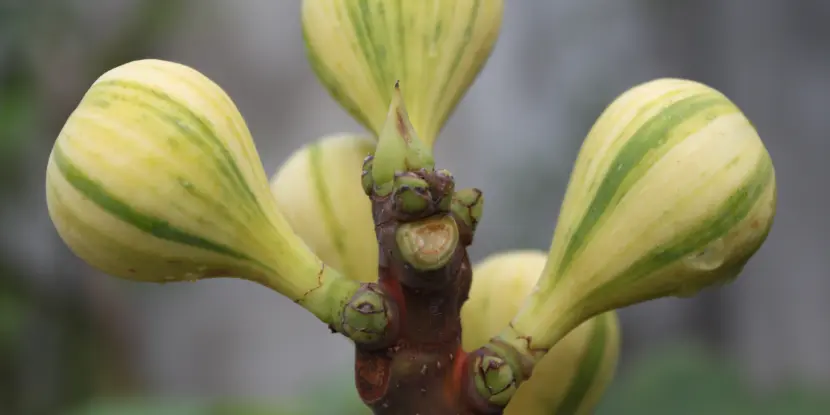
Tiger figs have distinctive green and yellow striping.
Propagating Fig Trees
Try this method to grow additional trees from your existing plant:
- Snip a 6–8-inch branch from your fig tree during winter.
- Remove leaves and dip the cut end into rooting hormone.
- Plant the cutting in a pot with well-draining soil. Keep the soil moist but not waterlogged.
- Roots should form within a couple of months, and new leaves will appear.
Steps for Planting
- Choose a sunny location with well-draining soil.
- Dig a hole twice the size of the root ball.
- Place the tree in the hole, ensuring the roots spread naturally.
- Backfill with soil and water thoroughly.
- Add a layer of mulch around the base to retain moisture.
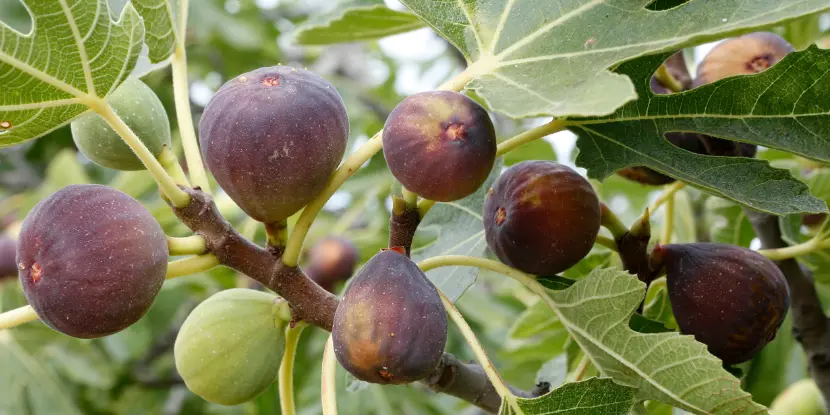
Mission figs ripening on the tree.
Fig Tree Care
Once planted, fig trees don’t need much attention, but consistent care will make them the happiest plants. Most start producing fruit 2–3 years after planting.
Water
Young Trees
- Water regularly (about 2–3 times a week) for the first year to help establish root growth.
- Ensure soil stays evenly moist, but not waterlogged.
Mature Trees
- During hot, dry spells, water thoroughly and deeply once a week.
- Avoid over-watering, which can cause root rot.

The Brown Turkey fig tree produces fruit twice a year.
Fertilizer
- Apply fertilizer in early spring, before new growth appears.
- Use a balanced fertilizer (10-10-10) or one specifically designed for fruit trees.
- Avoid over-fertilizing; too much nitrogen can reduce fruit production.
Pests & Diseases
Fig trees are quite hardy. However, they may encounter the following issues:
- Fig rust: This fungal disease causes yellow spots on leaves and can defoliate your tree if left untreated. Keep your fig tree well-pruned to prevent fig rust and remove any infected leaves.
- Fig mosaic virus: This viral infection causes deformed leaves and fruit on your fig tree. This disease has no cure, so removing and destroying infected plants is the best course of action.
- Fig beetles: These insects feed on ripe figs and can cause damage to your fruit. Handpick the beetles off the tree or use organic insecticides to prevent a large infestation.
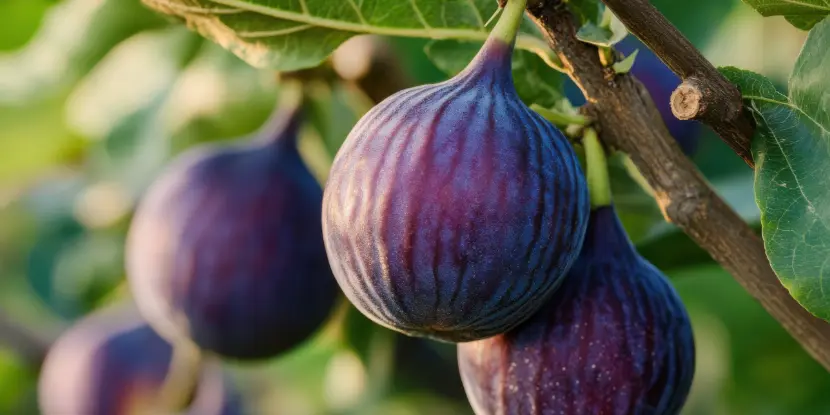
Fat, ripe purple figs ready for harvest.
Pruning
Pruning fig trees maintains their shape and encourages healthy fruit production.
- Prune in late winter while the tree is dormant.
- Remove any dead, damaged, or diseased branches.
- Thin the canopy by removing about one-third of the oldest branches.
- Prune back any branches growing sideways or crossing over each other.
- Trim back new growth to 5–6 leaves to encourage fruiting shoots.
Growing Fig Trees in Pots
Growing fig trees in pots offers several benefits for gardeners with limited space or challenging climates.
- Potted fig trees can be easily moved indoors during colder months, protecting them from frost and severe weather.
- Potted fig trees need little planting space.
- Pots manage the tree’s size, making maintenance and harvesting more manageable.
- Pots allow for more control over soil conditions, watering, and nutrients.
Steps for Potting
- Select an 18–24-inch container with drainage.
- Use a well-draining potting mix enriched with organic matter.
- Place the fig tree in the pot, ensuring the roots are spread out evenly. Cover with soil, leaving space between the soil surface and the rim of the pot for watering.
- Keep the soil moist but not soggy, allowing the top inch of soil to dry out between waterings.
- Feed the tree with a balanced fertilizer every four weeks during the growing season to promote healthy growth and fruit production.
- Place the pot in a location that receives at least 6–8 hours of direct sunlight daily.
- Repot the tree in a larger container every 2–3 years, or refresh the top layer of soil to support continued growth.
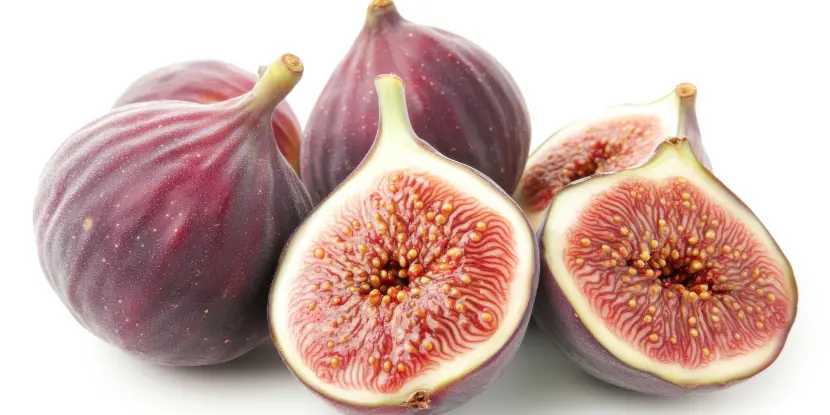
Sliced purple figs reveal their sweet, soft flesh.
Harvesting Figs
Figs are ready to harvest when they’re soft to the touch and starting to bend at the stem. Timing is crucial since figs don’t ripen off the tree. Enjoy them fresh, dried, or in your favorite recipes.
If birds are snacking on your figs, try covering your tree with netting to protect your fruit.
Enjoying Fresh Figs
You can eat your figs straight off the tree or incorporate them in these tantalizing recipes.
- Fresh Fig Salad — Slice fresh figs and mix with your favorite greens, nuts, and a light vinaigrette dressing for a refreshing salad.
- Grilled Figs — Cut figs in half and lightly grill until caramelized. Serve as a side dish or on top of grilled whatever.
- Fig Jam — Cook sliced figs with sugar and lemon juice to make a flavorful jam that can be used as a spread or dessert topping.
- Baked Figs — For an elegant appetizer, stuff whole figs with goat or cream cheese, wrap them in prosciutto, and bake them until the cheese melts.
- Fig and Prosciutto Flatbread — Top a pre-made flatbread with sliced figs, prosciutto, and arugula and drizzle with balsamic glaze for a delicious and easy meal or appetizer.
- Baked Brie with Figs — Slice figs on a wheel of brie cheese, drizzle with honey, and bake until the cheese is soft and gooey. Serve as a decadent appetizer or dessert.
- Fig Chutney — Simmer figs with onion, apple cider vinegar, brown sugar, and spices to create a flavorful chutney that pairs well with cheese.
- Grilled Fig and Prosciutto Skewers — Alternate slices of fresh figs and prosciutto on skewers and grill for a quick and easy appetizer or side dish.

Figs can be added to salads, grilled, sliced onto flatbread and cheese, or enjoyed fresh or dried.
FAQs: Fig Tree Care
Q: How often should I water my fig tree?
Water young trees weekly. Depending on the climate, mature trees should be watered every 10–14 days.
Q: Can I grow fig trees indoors?
Yes, smaller varieties like “Petite Negra” can grow indoors in containers.
Q: Do fig trees self-pollinate?
Most common varieties, like Black Mission and Brown Turkey, are self-pollinating.
Q: How long does it take for a fig tree to bear fruit?
Fig trees typically start producing fruit 2–3 years after planting.
Q: What’s the best time of year to plant a fig tree?
Early spring or late fall are ideal planting times.
Q: Can I use figs right off the tree?
Yes! Fresh figs are perfect for snacking straight from the tree.
Q: Why aren’t my figs ripening?
Factors like over-fertilizing or insufficient sunlight may delay ripening.
Q: How often should I prune my fig tree?
Once annually, ideally in late winter or early spring.

